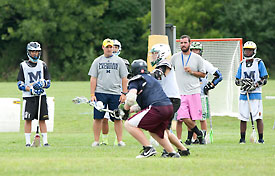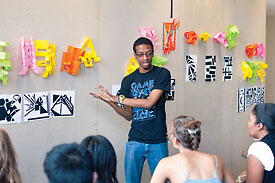Some summer camps are about swimming in the daytime and roasting marshmallows at night.
But at U-M, a growing number of summer camps give high school students an opportunity to get a head start learning about a field of study, and student athletes a chance to boost chances for success in their chosen sport.


Ken Broschart, (second from left) assistant Men’s Lacrosse coach, and Chris Cooper, a lacrosse coach with Michigan State University, guide a Michigan Lacrosse Camp session at Mitchell Field on North Campus. Over the summer, roughly 8,200 youths attend more than 200 academic and sports camps at U-M. Photo by Martin Vloet, U-M Photo Services.
Evan Hoye, incoming U-M freshman and recent graduate of Renaissance High School in Detroit, explains the theory behind his construction to fellow students at the ArcStart architecture camp presented by the A. Alfred Taubman College of Architecture. Photo by Scott Soderberg, U-M Photo Services.
Evan Hoye, a recent graduate of Renaissance High School in Detroit and incoming U-M freshman, says the experience is life changing.
“I saw a flier for ArcStart (the A. Alfred Taubman College of Architecture and Urban Planning summer camp) in my art teacher’s room and then I saw it in my counselor’s office too — it was fate,” he says. “I love architecture because it’s both artistic and mathematical, that’s where my skills blend.”
Brian Seggebruch, an Okemos High School senior who seeks to win a lacrosse scholarship to an area college, just attended his second Michigan Lacrosse Camp. “It’s a lot of fun and there are a lot of great coaches from all over the state; they coach you on a personal level,” he says.
Over the summer, roughly 8,200 youths attend more than 200 camps at U-M camps. Their focus ranges from computers to fine arts to sports, says Pamela Staton, Director of Conferences. “We’ve seen the numbers increasing over time. Attendance peaked at 10,000 around 2003, but the economy has impacted camps attendance too. We’re slowly working our way back,” she says.
“Camp offerings have grown in diversity, and there are many more women’s sports camps than before,” Staton says. “We’ve also seen more camps that are business related, and camps focusing on engineering or technology.”
While the main attraction is an opportunity to hone skills and have fun, Staton says, “I think that kids would tell you that they love staying in the residence hall and being on campus in a camp-centered environment. Parents tell us that they’re thankful about the safety measures we take.”
Building a future at architecture camp
The second week of ArcStart opens in the third floor studio in the Art and Architecture Building on North Campus. The first week, students were given pieces of colored of paper and asked to construct something out of each separate piece. Now, they take turns explaining their creations before the group.
“What we’re going to do is a typical architectural review,” Mashawnta Armstrong, a graduate of the architecture program (M.Arch. ’08) and lecturer, tells the group. Hoye stands before his constructions, tacked to a wall as fellow campers look on. “I want buildings to have a purpose in addition to having a design,” he says. “A building is not just a piece of art, it is a tool that must serve many different purposes.”
To be considered for ArcStart, applicants write a 500-word essay explaining their interest, submit high school transcripts, and two letters of recommendation. A portfolio showing artistic and creative strengths is optional.
The camp, which began in 2009, this year drew 130 applications, up from 35-40 in each of the previous years, Armstrong says. During the first week, the 18 ArcStart campers attended lecture sessions that covered basic architectural precepts. They journeyed to Belle Isle in Detroit and sketched the Windsor skyline and Detroit landmarks.
Campers also viewed the Academy Award-winning documentary “Maya Lin: A Strong Clear Vision.” It tells the story of Lin, who won a competition to design the Vietnam Veterans Memorial in Washington, D.C., while a student at Yale.
“We want to introduce them to university life, how to be an architectural student, and the professional practice of architecture,” Armstrong says.
Richa Agarwal, a junior at Sylvania Southview High School in Toledo, Ohio, discovered the camp online. “I really like interior design, color schemes and designing the inside and outside of buildings, so I thought architecture camp would be a good step toward a future in interior designing,” she says.
One week into the class, Agarwal says, “The project we did with all the colorful paper and making buildings and abstract things really got to me. I never knew that with one sheet of paper you could do so much, by just making cuts and folding.”
After camp sessions end at 5 p.m. each day, students return to their lodgings in Bursley residence hall to eat and watch videos, play soccer or basketball, or venture out in groups to explore Ann Arbor. The camp includes a three-day trip to Chicago to view architecture. It culminates in students presenting their final project, a pavilion for Matthaei Botanical Gardens.
Lacrosse surges in popularity
Known as a sport created by Native Americans and initially popular as a varsity sport along the eastern seaboard and Canada, lacrosse also is growing in popularity as a high school and college sport throughout the United States. Originally played as a club sport at U-M since 1940, the U-M Men’s Lacrosse Team will compete this year as a varsity squad for the first time, in the Eastern College Athletic Conference. A U-M women’s team will be ready for NCAA Division I varsity competition in the 2012-13 academic year.
“It’s fast-paced, it’s athletic, there’s lots of scoring. It’s growing at the youth level incredibly fast,” says Men’s Lacrosse Director of Operations Joe Hennessy. Attendance has grown from about 250 student campers four years ago to 330 today.
“It’s a great team sport, but it allows for individual creativity,” says John Paul, men’s lacrosse coach. He also oversees U-M’s lacrosse camps, now in their 12th year. Paul says the camps technically are for boys, yet several female goalies have taken part.
At camp sessions, much of the focus is on stick work and refining technique. “They need to get on the wall, which means throwing and catching against a wall. They need to use both hands. They should be shooting a lot of balls, every day. Good, fundamental repetitions are the key to improving. In addition, watching great lacrosse on TV or in person can help young players find role models to emulate,” Paul says.
Seggebruch, who hopes to be a college player, says, “You have to be very quick on your feet and be agile, have very good hand-eye coordination and pass and catch very well. You also have to be aware of your surroundings to cut through people and make a decent shot.”
Lacrosse campers also stay in Bursley Hall, as nearby Mitchell Field has sufficient space to accommodate players. Campers arise at 8 a.m. to eat breakfast and attend morning, afternoon and evening camp sessions, with breaks for lunch and dinner.
Seggebruch says what he likes best about the camp are one-on-one sessions with coaches. During his session, Seggebruch says the coach focused on his footwork and positioning, to help him become a more effective defensive player. “They helped me with positioning with my feet and where to position myself on the field in relation to the attacker, and how to check their stick or body to get the ball for our team,” he says.
“Those individual sessions are one of the things that sets our camps apart,” Paul says.

